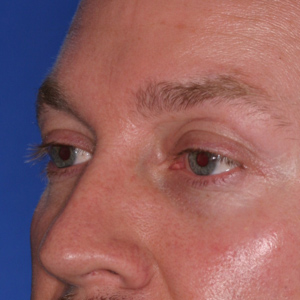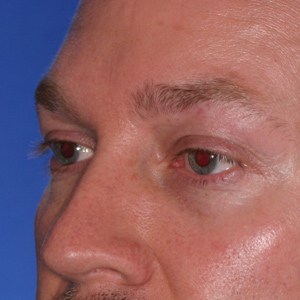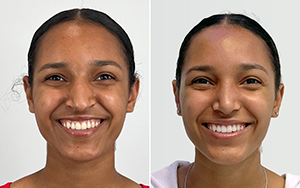Injectable Fillers Dr Cruises Philosophy
Joseph T Cruise, MD's Soft Tissue Filler Philosophy
Most common Soft Tissue Fillers:
Juvéderm® | Fat | Cosmoderm® | Restylane® | Radiesse® | Sculptra® | Collagen |
- Overview of Soft Tissue Fillers
- Full Face Rejuvenation
- Are You a Good Candidate?
- Benefits of Soft Tissue Fillers
- Joseph T Cruise, MD’s Soft Tissue Filler Philosophy
- Prior to the Procedure
- Soft Tissue Filler Anesthesia
- After the Procedure
- Recovery from Soft Tissue Fill
- Possible Complications
- Soft Tissue Filler Cost and Financing
- Soft Tissue Filler Words to Know
- Before and After Soft Tissue Filler Pictures
 Soft Tissue Fillers have really come a long way in the past few years. Before we were limited to collagen. Now, we have an array of longer lasting fillers with more on the horizon. While I use these products often in my practice, I am cautious to make sure that the benefits are there without significant risk prior to using them. Currently, in my practice I use all of the products listed above. I have found that each one has its usefulness in a particular area.
Soft Tissue Fillers have really come a long way in the past few years. Before we were limited to collagen. Now, we have an array of longer lasting fillers with more on the horizon. While I use these products often in my practice, I am cautious to make sure that the benefits are there without significant risk prior to using them. Currently, in my practice I use all of the products listed above. I have found that each one has its usefulness in a particular area.
The reason why I like them so much is because they fill in the "missing link" within plastic surgery. As a plastic surgeon I am trained to remove, suspend, tighten, lift, and contour but, prior to soft tissue fillers, I was limited in one crucial step. How to fill. The importance of soft tissue volume has been brought to the forefront of plastic surgery development. I am a avid proponent. The reason is that a significant component of aging is either soft tissue descent or loss. With age, not only do tissue fall but often they just go away; leaving a aged, gaunt appearance.
Often, skin laxity is another significant component of aging. This is why I often combine the two procedures, skin tightening and soft tissue filling, to get the most natural result possible. The reason why it is natural is because the root cause of the problems are being addressed. The third component of facial rejuvenation is skin quality. This is treated with chemical peeling or laser in conjunction with a good skin care regimen.
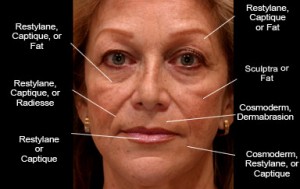
Aging Woman
Let us look at the aging face above. I would like to go over my preferred treatments for these problems. As we age, we notice that the cheek fat that was once firmly perched on top of the cheek bones begins to descend. This descent goes primarily to two places. One, above the upper lip creating a more pronounced upper lip fold (naso-labial fold). The second place is over the jaw line resulting in jowling. When these two problems become significant, correction is most effectively treated with a face lift by a skilled plastic surgeon. Soft tissue fillers, however, do a very good job of filling in the wrinkles and depressions left behind by the descending or loss of facial fat.
Again, look to the right and notice where fat descent or fat loss creates the obvious signs of aging. This may surprise you. Many people seek consultation with Joseph T Cruise, MD saying "Joseph T Cruise, MD, please remove the excess skin from my eyelids and cheeks." Skin excess often is not the only culprit especially in younger patients. Volume loss is responsible as well.
From top to bottom, lets review the areas where volume loss and/or descent is the major issue. These issues were outlined in the Overview section. Now, I will go over my preferred treatment. Remember, each patient has individual problems. The following is a general overview of how most patients are treated in my practice.
- Forehead Wrinkles
As we age, the forehead wrinkles become more and more evident. This is not because the muscles have gotten larger but because the subcutaneous fat over the muscles has gone away. With the fat gone, there is no longer a nice, cushy buffer between the skin and muscle. Therefore, the muscle acts directly on the skin; hence, the wrinkles.
Treatment. Soft tissue filling within the entire forehead would be useful but is not done often because of the size of the area being treated. This is sure to change in the future. For now, however, the most effective treatment is Botox®. Decreasing the muscle motion helps tremendously. One must be careful not to inject Botox® over the lateral portion of the forehead or the brow will sag. Botox® on either side of the eye brow, however, can actually raise the brow a little.
- Temple hollowing
Another sign of aging is the gaunt look that begins to develop within the temple area. Eventually, you can see the outline of the skull as the fat descends or goes away.
Treatment. Soft tissue filling provides a remarkable improvement to this gaunt appearance. It fills in the depression and obscures the skull that is beginning to poke through.
- Eye Brow and Upper Eyelid Sag
As described above, This is an area that patients of Joseph T Cruise, MD often ask for skin removal or brow elevation. While this may be the case, fat loss is usually also to blame. To help explain this look at the picture on the right of the young model and the older woman. Look at the position of the brow. They are both at about the same level. If so, what causes the appearance of brow sag in the older woman?


Now look at the soft tissue volume. In the young model the eyebrow and upper eyelid is full and youthful. The older person has significantly less fat. This creates a hollow, older appearance.
In reality, both the appearance of brow sag and the excess of upper eyelid skin are caused primarily by the same problem; loss of soft tissue volume. The reason why the brows appear to sag in the older woman is because without this plump fat BELOW the eyebrow there is a deep, hollow crease. This gives a sunken, aged appearance.
Ironically, aggressive removal of the excess skin will accentuate this hollowness. Some surgeons still remove fat from the eyelid which is almost never necessary except in some ethnic groups such as asians.
Treatment. Adding soft tissue volume just below the eyebrow does an excellent job of plumping up the eyebrow and filling in the hollow. This area responds very well and many people would benefit from more volume. There still may be a role for conservative brow lifting and skin removal of the upper lid. In Joseph T Cruise, MD's practice, he often combines the procedures. Once again, do not have too much skin removed from the upper eye lid as this look is often worse than the original problem.
- Lower Eyelid Bags, Crease
With the descent of the cheek fat, the fat leaves the lower eyelid as it heads south. This exposes the underlying bone and creates a crease. Sometimes, this crease is present even in young patients. When this crease occurs there is often an excess of fat just above the crease, i.e. bags. There are many factors involved in this area with the aging process but, soft tissue loss, is a significant factor.
Treatment. Treatment depends on what is causing the problem and must be individualized. We will try to break it down into the major factors. I will outline the way I think of it during your consultation. This systematic approach allows each component of the lower lid to be evaluated. One caveat, this is a very delicate area. Therefore, it is imperative that you have a competent plastic or oculoplastic surgeon addressing these areas.
- Excess skin. This must be demonstrated by being able to pull just the skin away from the lid. Sometimes, there are just fine wrinkles that are best managed with a chemical peel or laser in conjunction with a skin care program. It is important not to remove too much skin or the lower lid may droop. Often, I will remove only skin and chemical peel the rest of the lid
- Bags under the eye. Excess fat of the lower lid represents fat that is normally located under the eyeball. This fat herniates forward to create that characteristic bag appearance. Often, this pushing forward of fat is accentuated by the descent and/or loss of the cheek fat. With the cheek fat gone, the fat bags becomes more obvious. Typically, I will remove the lower lid fat bags through a transconjunctival incision. This incision is located on the inside of the lid and can not be seen. In addition, I inject a soft tissue filler within the crease. This combination provides a great result. I would like to point out that if the bags are not too bad that they can be camouflaged with the filler. This is less invasive.
- Crease under the eye. The severity of the crease depends on the patient. Some patients just have it on the nasal side. Others have it extending across the entire lower lid. This crease can be improved dramatically with soft tissue fillers. Once the crease is plumped out the lid and the cheek blend together like that seen in the more youthful lower lid. One caveat, the crease will never completely go away but it can be dramatically improved.
- Loss of Cheek Mound.
Full Cheek fat is what defines a youthful cheek. As depicted in the figure, cheek fat descends with age. Some of the fat simply goes away. This accounts for the loss of cheek fullness and the gaunt look of the face. The fat ends up above the upper lip creating an unattractive lip fold or it descends over the jaw line creating a jowl.
Treatment. First of all, it is important to determine what needs to be corrected. The only reliable way to correct the upper lip fold and the jowling is to do a face lift to suspend the cheek fat back up to where it was during youth. If the problem is the loss of cheek volume then I have two choices. In the past, I would use cheek implants to correct this volume deficit. I still use them as it does a good job correcting the volume loss. Recently, I have used soft tissue filling to correct this. The cheek responds well to fat transplantation. Fat transplantation may take several sessions but it works well. I also have been using Radiesse® and Sculptra® in the cheek. These have shown to be effective as well and do not require a liposuction of the abdomen or thighs to harvest the fat.
- Naso-Labial Crease
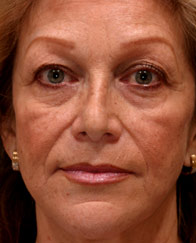
Picture of woman demonstrating the signs of facial aging.
- The deepening of this crease is caused by the same process that causes loss of cheek fat. As the cheek fat descends it gathers in this fold. Just below this fold forms a deeper crease.
Treatment. One way to get permanent improvement of this fold is to liposuction the area. This provides good results that are permanent. Of course, I am a firm believer in maintaining as much facial fat as possible, therefore, my first choice would be to do a face lift. Liposuction, however, is an excellent alternative with a much quicker recovery. In addition, it can be done under local anesthesia.
In addition to liposuction, injecting a soft tissue filler directly into the crease works good as well. Doing the liposuction first, followed by the soft tissue filler is the best option.
- Lip Augmentation
Lips are different than the other areas of the face. Soft tissue fillers are used in other areas to rejuvenate but fillers in the lips are also performed to enhance the sensual component of the lip. This is why the lips are unique. Consequently, this is the reason why it is the most common area augmented with fillers. One should not underestimate the rejuvenation effects of soft tissue fillers on the lips. Lip augmentation is an excellent way to make the entire face look younger. This is because as we age our lips get smaller.
Treatment. Soft tissue augmentation to the lips creates an outstanding result. End of story. It works well. Its predictable. Short down time. Minimal complications. Relatively inexpensive. The only down side is that it is not permanent. I usually use Restylane® or Captique®. Both are hyaluronic acids that act similarly.
I use Cosmoderm® to treat the fine wrinkles of the upper lip. It only lasts 2-3 months but it does a remarkable job with essentially no down time. A more permanent solution to these fine wrinkles is dermabrasion. This, of course, requires 1-2 weeks of healing followed by some redness.
- Marionette Lines.
Marionette lines are extensions of the naso-labial folds. They extend from the corner of the mouth down to the jaw line. It got it's named because these lines look like the lines formed by the moving mouth of a marionette puppet. It is not uncommon to see these lines in young people as well.
Treatment. For great results and a quick down time, I use Cosmoderm®. It does a good job of plumping these fine lines out. Once again, the result lasts only about 3 months. A longer lasting result is to detach this line from the underlying tissue and inject a soft tissue filler. I usually use Restylane®. This is done under local anesthesia but it may cause bruising. The results are not quite as good as Cosmoderm® but they can last a year or longer.

